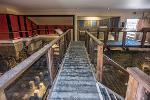About Binchester Roman Fort
Binchester Roman Fort gives you an insight into what life was like for the Romans in County Durham.
Explore the exceptionally well-preserved remains of not just one but two bath-houses. One lies inside the fort and has one of the most intact hypocaust (underfloor) heating systems in the whole of Britain. The protective structure over this bath-house was replaced in 2018 by a more sturdy successor which features improved interpretation and decoration. The other bath-house lies outside the fort and is even better preserved with walls still standing to a height of more than two metres (six feet) above Roman floor level. Find out why taking a bath in Roman times was about more than just getting clean. Walk in the footsteps of Roman soldiers within the remains of the commanding officer's house - see if you can find the 'Beast of Binchester' among the ruins.
Transcript of Binchester bath house (no audio) (PDF, 126 KB)
Background history
Binchester (Vinovia) was founded around 80 AD and for a time one of the largest Roman military installations in the whole of Northern Britain. About 7 hectares in size it was large enough to have accommodated a battle-group formed of several cohorts of legionary infantry and one or more units of auxiliary cavalry. Even when it was reduced to 4 hectares around 160 AD it was still the largest fort in County Durham.
We know from inscriptions that the garrison of this later fort was a cavalry unit originally recruited in central Spain accompanied at some point by a unit of cavalry originating from the area we now know as Holland. The fort, which continued to be occupied down to the end of the Roman period, was accompanied by a large civil settlement around it. People continued to live in the fort for several centuries after Britain ceased to be part of the Roman Empire.
Excavations
The lengthy process of recording and analysing the information recovered during the international field-school excavation of 2009-2015 (a partnership involving our Archaeology Section, Durham University Archaeology Department and Archaeological Services, along with Stanford and Texas Tech Universities from the USA) and the cemetery excavation by Durham University in 2016-17 is currently underway.
Education
A school room, workshop activities and guided tours can be pre-booked in advance for school groups and small parties (up to 50).
- Email archaeology@durham.gov.uk
- Telephone 01388 663 089
- Email archaeology@durham.gov.uk
- Telephone 03000 267 013























 Share this page on Facebook
Share this page on Facebook
 Share this page on Twitter
Share this page on Twitter
 Print this page
Print this page





